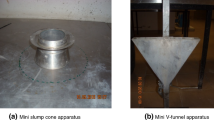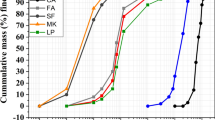Abstract
The link between flow properties and the formulation is actually one of the key-issues for the design of self-compacting concretes (SCC). As an integral part of a SCC, self-compacting mortars (SCMs) may serve as a basis for the design of concrete since the measurement of the rheological properties of SCCs is often impractical due to the need for complex equipment. This paper discusses the properties of SCMs with mineral admixtures. Portland cement (PC), metakaolin (MK), and fly ash (FA) were used in binary (two-component) and ternary (three-component) cementititios blends. Within the frame work of this experimental study, a total of 16 SCMs were prepared having a constant water-binder (w/b) ratio of 0.40 and total cementitious materials content of 550 kg/m3. Then, the fresh properties of the mortars were tested for mini-slump flow diameter, mini-V-funnel flow time, setting time, and viscosity. Moreover, development in the compressive strength and ultrasonic pulse velocity (UPV) of the hardened mortars were determined at 1, 3, 7, 14, and 28 days. Test results have shown that using of FA and MK in the ternary blends improved the fresh properties and rheology of the mixtures when compared to those containing binary blends of FA or MK.









Similar content being viewed by others
References
Corinaldesi V, Moriconi G (2004) Durable fiber reinforced self-compacting concrete. Cem Concr Res 34:249–254
Edamatsu Y, Nishida N, Ouchi M (1999) A rational mix-design method for self-compacting concrete considering interaction between coarse aggregate and mortar particles. In: Proceedings of the first international RILEM symposium on self-compacting concrete, Stockholm. Sweden, pp 309–320
Khayat KH, Guizani Z (1997) Use of viscosity-modifying admixture to enhance stability of fluid concrete. ACI Mater J 94(4):332–340
Yurigi M, Sakai M, Sakata N (1995) Viscosity agent and mineral admixtures for highly fluidized concrete. In: Sakai K, Banthia N, Gjorv O (eds) Proceedings of concrete under severe conditions: environment and loading, vol 2. E&FN Spon, Japan, pp 995–1004
Khayat KH (1998) Use of viscosity-modifying admixture to reduce top-bar effect of anchored bars cast with fluid concrete. ACI Mater J 95(2):158–167
Zhu W, Gibbs JC (2005) Use of different limestone and chalk powders in self-compacting concrete. Cem Concr Res 35:1454–1462
Sonebi M, Bartos PJM (1999) Hardened SCC and its bond with reinforcement. In: Proceedings of the first international RILEM symposium on self-compacting concrete. Stockholm, Sweden, pp 275–289
Fujiwara H, Nagataki S, Otsuki N, Endo H (1996) Study on reducing unit powder content of high-fluidity concrete by controlling powder particle size distribution. Concrete Library of JSCE 28:117–128
Khayat KH, Manai K, Trudel A (1997) In situ mechanical properties of wall elements cast using self-consolidating concrete. ACI Mater J 94(6):491–500
Sedran T, de Larrard F (1999) Optimization of self compacting concrete, thanks to packing model. In: Proceedings of the first international RILEM symposium on self-compacting concrete. Stockholm, Sweden, pp 321–332
Khayat KH (1999) Workability, testing, and performance of self-consolidating concrete. ACI Mater J 96(3):346–353
Gesoğlu M, Özbay E (2007) The effects of mineral admixtures on fresh and hardened properties of self compacting concretes. Mater Struct 40:923–937
Bouzoubaa N, Lachemi M (2001) Self-compacting concrete incorporating high volumes of class F fly ash preliminary results. Cem Concr Res 31:413–420
Sabir BB, Wild S, Bai J (2001) Metakaolin and calcined clay as pozzolans for concrete: a review. Cem Concr Comp 16:441–454
Sabir BB, Wild S, Khatip JM (1996) On the workability and strength development of metakaolin concrete. In: Dhir RK, Dyer TD (eds) Concrete for environmental enhancement and protection. (E&FN Spon), pp 651–656
Zhang MH, Malhotra VM (1995) Characteristics of a thermally activated alumino-silicate pozzolanic material and its use in concrete. Cem Concr Res 25(8):1713–1725
Güneyisi E, Mermerdaş K (2007) Comparative study on strength, sorptivity, and chloride ingress characteristics of air-cured and water-cured concretes modified with metakaolin. Mater Struct 40:1161–1171
Güneyisi E, Gesoğlu M, Mermerdaş K (2007) Improving strength, drying shrinkage, and pore structure of concrete using metakaolin. Mater Struct (in press). doi:10.1617/s11527-007-9296-z
FIP Commission on Concrete (1988) State of art report. Condensed silica fume in concrete. Thomas Telford, London, pp 1–37
Zhu W, Sonebi M, Bartos PJM (2004) Bond and interfacial properties of reinforcement in self-compacting concrete. Mater Struct 37:442–448
EFNARC (2002) Specification and guidelines for self compacting concrete. Feb. 2002, pp 29–35. Free pdf copy downloadable from http://www.efnarc.org
Domone PL, Jin J (1999) Properties of mortar for self-compacting concrete. In: Proceedings of the first international RILEM symposium on self-compacting concrete. Stockholm, Sweden, pp 109–120
ASTM C109/C 109M-99 (1999) Standart test method for compressive strength of hydraulic cement mortar. Annual book of ASTM standards, 04.01. Cement, Lime, Gypsum
ASTM C 403/403M-99 (1999) Standard test methods for time of setting of concrete mixtures by penetration resistance. Annual book of ASTM standards, 04.02 Concrete and Concrete Aggregates
Felekoglu B, Tosun K, Baradan B, Akin A, Uyulgan B (2006) The effect of fly ash and limestone fillers on the viscosity and compressive strength of self-compacting repair mortars. Cem Concr Res 36:1719–1726
Barnes HA (1995) A review of slip (wall depletion) of polymer solutions, emulsions and particle suspensions in viscometers; its cause, character, and cure. J Non-Newton Fluid Mech 56:221–251
Brooks JJ, Megat Johari MA, Mazloom M (2000) Effect of admixtures on the setting time of high-strength concrete. Cem Concr Comp 22:293–301
Sun Z, Voigt T, Shah SP (2006) Rheometric and ultrasonic investigations of viscoelastic properties of fresh Portland cement pastes. Cem Concr Res 36:278–287
Antiohos S, Tsimas S (2004) Investigating the role of reactive silica in the hydration mechanisms of high calcium fly ash/cement systems. Cem Concr Comp 27:171–181
Kiattikomol K, Jaturapitakkul C, Solkpiriyakij C, Chutubtim C (2001) A study of ground coarse fly ashes with different fineness from various sources as pozzolanic materials. Cem Conc Comp 23:335–343
Acknowledgements
Author would like to acknowledge the assistance of Mr. Ferhan Saygılı, Mr. Mustafa Erkan Kocabağ, and Mr. Vakıf Kiriş during the experimental phase of the study.
Author information
Authors and Affiliations
Corresponding author
Rights and permissions
About this article
Cite this article
Güneyisi, E., Gesoğlu, M. Properties of self-compacting mortars with binary and ternary cementitious blends of fly ash and metakaolin. Mater Struct 41, 1519–1531 (2008). https://doi.org/10.1617/s11527-007-9345-7
Received:
Accepted:
Published:
Issue Date:
DOI: https://doi.org/10.1617/s11527-007-9345-7




